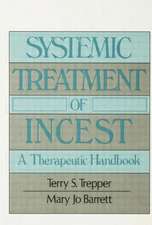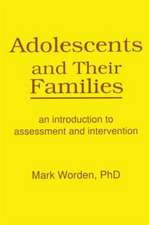The Web of Poverty: Psychosocial Perspectives
Autor Terry S. Trepper, Anne Marie Amberten Limba Engleză Paperback – iul 1998
The Web of Poverty helps you clearly see the effects of poverty by considering the cultural and social contexts of victims’lives. In doing so, it fills a gap in the literature caused by books that overlook personal issues and data related to individual experiences. Chapters address contentious and sensitive issues within a critical psychosocial perspective that informs concepts such as the subculture of poverty, social pathologies, and the “overclass.” Many of the topics and perspectives you'll explore in its pages are rarely considered together in one volume. Specifically, you'll read about:
- the plight of impoverished mothers and their children
- a comparison of the poverty of disadvantaged African Americans and poor white Americans
- health disadvantages of the poor
- the effects of poverty on school systems and the quality of education students receive
- the factors of age, race, and ethnicity that can lead to poverty
- a refutation of the notion of genetic inferiority of the poor
Poverty is often the cause of other social ills such as delinquency, which can destroy the social fabric of neighborhoods and limit opportunities to escape impoverished situations. The Web of Poverty will help you accurately see poverty as part of this “big picture.” It contains material from the fields of sociology, developmental psychology, family studies, economics, delinquency, ethnic studies, health, and behavior genetics. This amalgamation gives you a thorough psychosocial perspective.
Preț: 320.60 lei
Preț vechi: 460.54 lei
-30% Nou
Puncte Express: 481
Preț estimativ în valută:
61.35€ • 64.23$ • 50.88£
61.35€ • 64.23$ • 50.88£
Carte tipărită la comandă
Livrare economică 10-24 aprilie
Preluare comenzi: 021 569.72.76
Specificații
ISBN-13: 9780789002327
ISBN-10: 0789002329
Pagini: 310
Dimensiuni: 152 x 212 x 20 mm
Greutate: 0.57 kg
Ediția:1
Editura: Taylor & Francis
Colecția Routledge
Locul publicării:Oxford, United Kingdom
ISBN-10: 0789002329
Pagini: 310
Dimensiuni: 152 x 212 x 20 mm
Greutate: 0.57 kg
Ediția:1
Editura: Taylor & Francis
Colecția Routledge
Locul publicării:Oxford, United Kingdom
Cuprins
Contents Foreword
- Acknowledgments
- Introduction
- Origins of This Volume
- Volume Contents
- Intended Audiences
- Poverty in the United States and Canada
- Across the World
- Poverty in North America
- Canada and the United States
- The Extent of Poverty
- Other Aspects of Poverty
- The Gap Between Rich and Poor
- Mobility Out of and Back into Poverty
- The Reduction of Rural Poverty
- Conclusion
- Systemic Causes of Poverty
- Globalization of the Economy
- Evolving Structure of the Economy
- Relative Loss of Manufacturing Jobs
- Expansion of the Service Sector
- Increase in Part-Time Employment
- Increase in Low-Paying Jobs
- Increase in Two-Wage-Earner Families
- Higher Educational Requirements
- Job Relocation
- Emphasis on Financial Profit
- Unemployment
- National Debt
- Low Social Assistance Programs
- Low-Skilled Immigrants
- Conclusion
- Personal Causes of Poverty
- Single Parenting
- Single Parenting and Poverty
- Divorced Single Parenting
- Never-Married Parenting
- Effects on Children
- Poverty in the Family of Origin
- School Dropout and Lack of Education
- Additional Factors: Delinquency and Ill Health
- Conclusion
- Urban Neighborhoods in Poverty
- The Canadian Exception
- The Development of High-Poverty Neighborhoods
- Depletion of Neighborhood Resources
- Poor Neighborhoods and Negative Socialization of Children
- Poor Neighborhoods as Risk Factors for Children
- Homelessness
- The Nonpoor in Disadvantaged Neighborhoods
- Conclusion
- Schools and Education in Poor Districts
- Schools in Impoverished Neighborhoods
- Quality of School Personnel and Disadvantaged Families
- Disadvantaged Students and Schools
- Family Routine and Organization
- Parental Resources and Involvement in Schooling
- Low-Income Minority Students
- Involuntary and Voluntary Minorities
- Conclusion
- Disadvantaged Families
- Family Size
- Adolescent Single Parenting
- The Situation
- Consequences for Offspring
- Types of Single Adolescent Mothers
- Single Fathers: The Real Problem?
- Family Conflict and Spousal Abuse
- Child Abuse
- Child Neglect
- Abuse of Parents by Children
- Parenting Skills and Poverty
- Parental Dilemmas
- Conclusion
- Women, Children, and the Elderly
- Women
- Mothers in Poverty
- Their Burden
- The Matter of “Proper” Childrearing Practices
- Mothers as Victims
- Children
- The Extent of Child Poverty
- Consequences of Poverty for Children
- Negative Child Outcomes
- Homeless Children
- The Elderly
- Elderly Women
- Conclusion
- Visible Minorities, Discrimination, and Segregation
- Recent Roots of Inequalities
- Racial and Ethnic Inequalities and Poverty
- Segregation
- Work Discrimination
- Health Differentials
- Reduced Life Expectancy
- Conclusion
- Health and Illness Differentials
- Health and Socioeconomic Status
- Life Expectancy
- The Differentials
- Myths About Life Expectancy
- Explanation for Differentials
- Illness-Related Problems
- Psychiatric Problems
- Cognitive Problems
- Is More Medical Care the Solution?
- Conclusion
- Poverty and Delinquency
- Aspects of Delinquency
- Personal Pathways to Delinquency
- Causes of Delinquency
- Poverty and Delinquency
- Poverty and Social Control
- Poverty and Segregated Minorities
- Poverty and Dysfunctional Opportunity Structure
- Poverty and the Media
- Conclusion
- Poverty Undermines Genetic Potential
- Genetics and Child Outcomes
- Outline of Behavior Genetics Principles
- Genotype-Environment Correlations
- Genetically Influenced Chains of Events
- Environmentally Influenced Chains of Events
- Environmental Rather Than Personal Deficits
- Poverty Creates Inferiority
Descriere
The most interdisciplinary, integrated text on poverty, The Web of Poverty: Psychosocial Perspectives gives you a full understanding of poverty and its consequences, equipping you to affect social change. This unique book examines the social and personal causes of poverty, focusing on the consequences of poverty at the neighborhood and school levels and on families, children, and youth. Ethnic and racial minorities are considered throughout the text, and a chapter is devoted to the interface of poverty, segregation, and discrimination.























